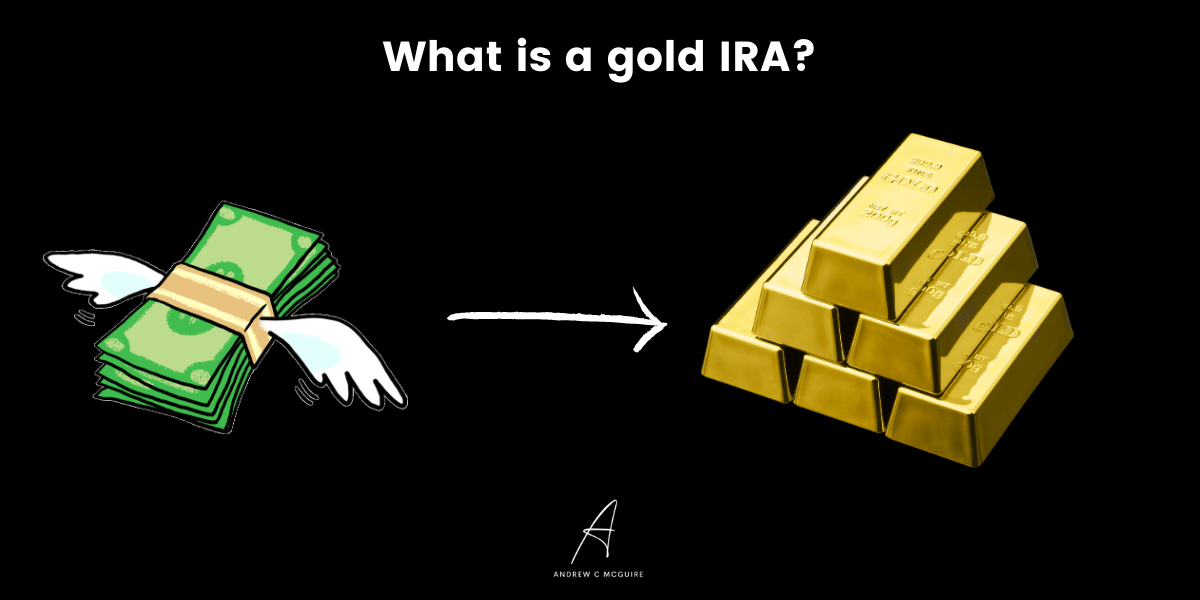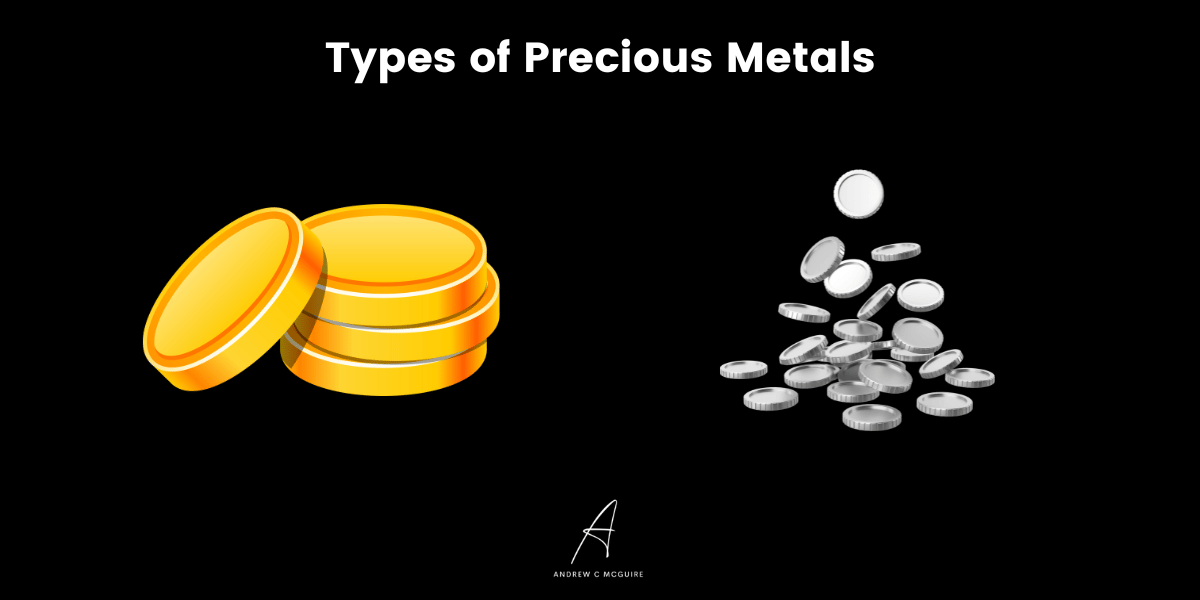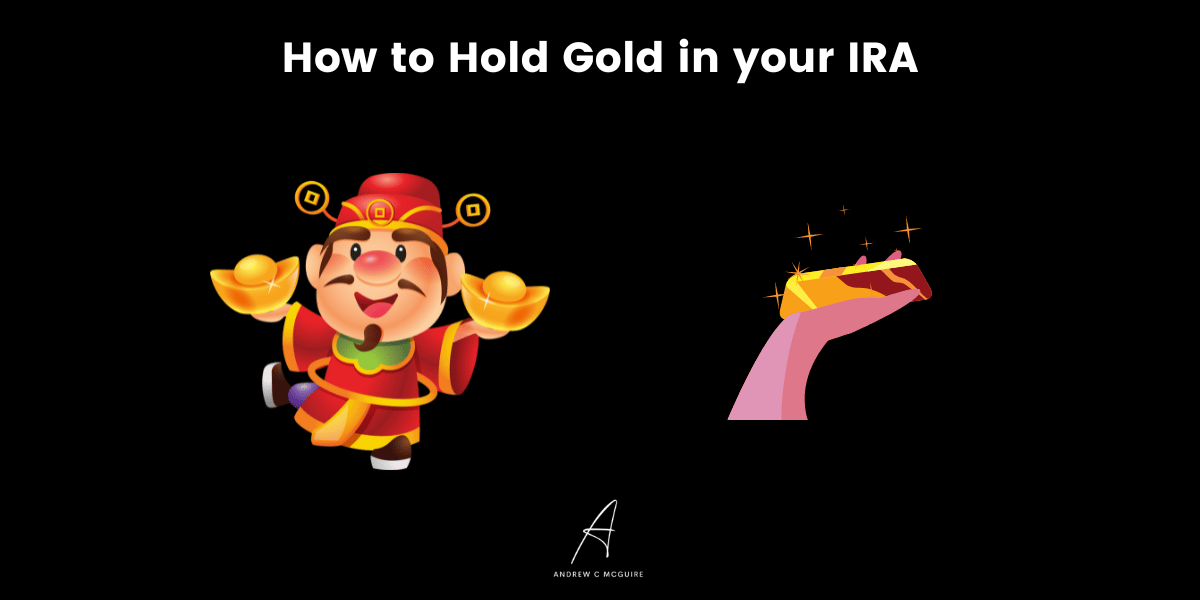Are you looking for a reliable and secure way to protect your wealth from inflation and recession? A gold IRA may be the perfect investment strategy for you. With so many options out there, it’s important to understand what exactly is a gold IRA, how it works, and its associated rules and regulations.
From learning about Gold IRA rollover rules to understanding how to buy gold in an IRA or hold physical gold in an account – I’ll cover everything you need know about a gold IRAs here.
What is a gold ira?
A Gold IRA, or Individual Retirement Account, is an investment vehicle that allows individuals to hold physical gold bullion in their retirement accounts. It is authorized by Congress and regulated by the Internal Revenue Service (IRS). The gold held in these accounts can be used as part of an individual’s retirement portfolio to protect against inflation and economic downturns.
How Does a Gold IRA Work?
Gold IRAs are set up like traditional IRAs with contributions made on a pre-tax basis from earned income. Contributions are limited each year depending on age and other factors determined by the IRS. Funds can then be invested into approved precious metals such as gold coins or bars, silver coins or bars, platinum coins or bars, and palladium coins or bars. These investments must meet certain fineness standards set forth by the IRS for inclusion in a gold IRA account. Once purchased, the metals are stored in an approved depository until they are ready to be withdrawn at retirement age.
Gold IRA Rollover Rules & Regulations
The rules governing how funds can be moved between different types of IRAs vary depending on whether it’s considered a rollover or transfer transaction; however both require that all funds remain within qualified custodians during the process. A rollover occurs when funds from one type of retirement account (such as 401(k)) are transferred directly into another type of account (such as Roth IRA) without being taxed first while still maintaining tax deferred status for future withdrawals; this requires that no money actually changes hands during the process since any cash received would become taxable income immediately upon receipt . On the other hand transfers involve moving assets from one custodian to another without changing its tax status which does not incur taxes but may have fees associated with it depending on your financial institution’s policies.
How To Buy Gold In An IRA
Buying gold through an Individual Retirement Account requires you to open up either a Traditional or Roth account with an approved custodian who will handle all transactions related to purchasing precious metals for your portfolio including storage costs if applicable; some companies also offer self-directed options where you manage everything yourself instead of relying on outside help which could potentially save money over time but comes with more risk due to lack of professional oversight.
I recommend you go with Augusta Precious Metals to help you figure out how to make this happen. I put together an overview of the best gold IRA companies that will help you with this.
Once you pick your precious metals IRA provider, you’ll need to
1
Open your Self Directed IRA Account
You’ll need to setup a self directed IRA before you can fund the account and purchase any physical metals in your new gold IRA account.
2
Fund your IRA account with fiat currency
Once your account is setup, you’ll need to fund it by moving funds from another IRA account as an IRA rollover.
3
Purchase Precious Metals
This is my favorite part because you get to pick the types of metals you’d like to have in your gold IRA. Depending on the company you picked, you’ll be able to pick from gold, silver, platinum and/or palladium.
4
Securely Store Your Precious Metals
Finally once your purchase has been completed, your assets should be securely stored away until you need to withdraw them either to partially liquidate or all your holdings.
How To Hold Gold In A Physical IRA
Holding physical gold inside an Individual Retirement Account involves having it shipped directly from a dealer vault facility to a secure location where it will remain safe until ready for use again.
Most dealers provide insurance coverage to ensure safety during transit, so there is no need to worry about potential theft or loss of value due to mishandling along the way.
Additionally, many custodians allow customers to store their own personal collection in a private depository in order to keep track of records and inventory in an easily accessible manner. You will be able to access the information quickly regarding a particular piece of property owned under your name on a specific date purchased, etc.
How does a gold IRA work?
A gold IRA is an Individual Retirement Account (IRA) that allows investors to hold physical gold in their retirement portfolio. This type of account works just like a traditional IRA, with the same rules and regulations, but it provides investors with the opportunity to diversify their portfolios by investing in a hard asset such as gold.
Gold IRAs can be used to purchase physical gold coins or bars, which are stored in secure vaults on behalf of the investor. Alternatively, they can also be used to buy shares of a gold mining company or other precious metals investments. The value of these investments will depend on market conditions and may fluctuate over time.
When setting up a Gold IRA, investors must select an approved custodian who will manage the account for them and ensure that all transactions comply with IRS regulations. They must then choose which type of assets they want to invest in – either physical gold or other precious metals investments – and make sure that these meet certain criteria set out by the IRS before making any purchases. Investors should also consider how much money they wish to allocate towards this investment strategy before proceeding further.
In order for funds from another retirement plan such as 401(k)s or 403(b)s to be transferred into a Gold IRA without incurring tax penalties, investors must complete what is known as a “rollover” process where funds are moved directly from one qualified plan into another qualified plan without passing through their hands first. It is important for individuals considering this option to understand all applicable rules and regulations regarding rollovers so that no mistakes are made during this process which could result in costly fees or taxes being incurred later down the line.
Finally, when holding physical gold within an IRA account there are specific tax rules that apply depending on whether you take delivery of your metal upon withdrawal or if you keep it stored within your custodian’s vault until retirement age.
As always when dealing with financial matters, it is a best practice for individuals seeking advice about how best to structure their own personal finances to consult professional advisors. I am not a financial advisor so you need to consult with yours.
Once you’ve consulted with you financial advisor, you will want to make sure you understand what the rules of the road are if you’re seriously considering doing this.
Gold IRA rollover rules and regulations
The first rule of thumb when it comes to a gold IRA rollover is understanding the difference between direct and indirect rollovers.
A direct rollover involves transferring funds directly from one qualified plan (such as an employer-sponsored 401k) into another qualified plan (such as an individual retirement account).
An indirect rollover requires you to withdraw the money from the original plan, then deposit it into the new account within 60 days. If this isn’t done correctly, taxes may be due on any amount withdrawn before being deposited into the new account.
Another important factor when considering a gold IRA rollover is knowing how much money can be transferred without incurring taxes or penalties. Generally speaking, individuals can transfer up to $6,000 per year without incurring any tax liabilities; however, if more than $6,000 is rolled over in one year additional taxes may apply.
It’s also important to note that some plans have their own specific limits for transfers so it’s best to check with your financial advisor for details about what applies in your situation specifically.
When doing a gold IRA rollover, it is important to know which types of assets are eligible for transfer and which ones aren’t allowed by law. Collectibles such as art or antiques cannot be held in an Individual Retirement Account (IRA). Generally speaking, most investments including stocks, bonds, mutual funds and ETFs are eligible for transfer provided they meet certain criteria set forth by IRS guidelines.
Additionally many precious metals such as silver coins, bullion bars and rounds can also be held inside of IRAs providing added protection against inflationary pressures while allowing investors access liquidity should they need it down the road.
Gold IRA rollover rules and regulations are an important part of protecting your wealth from inflation and a recession. Knowing these rules is key to making the best investment decisions for your future. Next, we’ll explore how gold can be used as an effective asset in a portfolio.
What kind of gold can I buy?
Buying gold in an IRA is a great way to protect your wealth from inflation and recession. Gold has been used as a store of value for centuries, so it makes sense to include it in your retirement portfolio. There are several ways to buy gold in an IRA, each with its own advantages and disadvantages.
Gold Coins
Gold coins are the most popular form of physical gold investments. They come in various sizes and weights, ranging from 1/10th of an ounce up to one full ounce or more. Popular coins include American Eagles, Canadian Maple Leafs, South African Krugerrands, Austrian Philharmonics and Chinese Pandas. When buying gold coins for an IRA account you must ensure that they meet IRS requirements – only certain types of bullion coins qualify for inclusion in IRAs.
Gold Bars
Gold bars can also be purchased for IRAs but there are some restrictions on their size and weight which vary depending on the custodian you use. Generally speaking though bars should weigh at least one troy ounce (31 grams) or more; larger bars may be available too but will usually incur higher premiums than smaller ones due to storage costs associated with them.
Gold Mutual Funds & ETFs
If you don’t want the hassle of storing physical gold then investing through mutual funds or exchange-traded funds (ETFs) might be a better option for you as these products track the price movements of spot prices without having any direct ownership over actual metal itself – meaning no need to worry about security issues either!
However these investments do not offer any protection against inflation since they simply follow market trends rather than owning actual precious metals themselves so investors should take this into consideration when making their decision here too!
Another option is purchasing physical gold through custodians who specialize in holding precious metals within IRAs, such as New Direction IRA or Equity Trust Company.
Both companies have experience dealing with self-directed accounts, including those containing physical assets like bullion coins and bars. The process works by transferring existing retirement funds into these specialized custodial accounts, whereupon investors can purchase approved items directly from approved dealers before having them securely stored away until needed again later on.
How to hold physical gold in an IRA
Gold is an attractive option for those looking to diversify their retirement portfolio and protect their wealth from inflation and a recession. An Individual Retirement Account (IRA) allows you to invest in gold, either through a custodian or directly.
A Gold Custodian
A gold custodian will hold the gold for you and manage your account. They are responsible for keeping track of all transactions related to the purchase, sale, storage, delivery and transfer of the gold held in your IRA. You can buy physical coins or bars from them or even exchange-traded funds (ETFs).
Self-Directed IRA
With this option, you set up a self-directed IRA with an approved financial institution that specializes in precious metals investments such as gold. This requires more knowledge about investing since you’ll be managing the account yourself instead of relying on someone else to do it for you. You’ll need to research which types of investments are allowed by IRS rules before buying any assets like coins or bars with your self-directed IRA funds.
Specialized IRAs
These specialized IRAs only allow investments in precious metals like gold so they may be ideal if that’s what you want to focus on exclusively when building your retirement portfolio. The process is similar to setting up a self-directed IRA but there may be additional restrictions depending on the type of specialized IRA being used so make sure to read all relevant documentation carefully before making any decisions regarding these accounts.
Before investing in physical gold through an IRA, it is important to understand the tax rules according to IRS regulations. This includes how much money can be contributed each year and when distributions can occur without incurring penalties or taxes due at withdrawal time. Failing to do so could lead to unexpected surprises when filing taxes or taking distributions from the account later on.
FAQs
What is the benefit of a gold IRA?
It provides protection against inflation and economic downturns, as the value of gold tends to remain stable even when other asset classes are volatile. Gold also has the potential for capital appreciation over time, making it an attractive option for long-term wealth preservation and growth. Additionally, gold IRAs offer tax advantages such as deferred taxes on gains until withdrawal or distribution from the account.
Is gold a good investment IRA?
Gold can be a good investment for an IRA, depending on the individual’s goals and risk tolerance. Gold has historically been seen as a safe-haven asset in times of economic uncertainty, so it may provide some protection against inflation or recession. However, gold is not without its risks; prices can fluctuate significantly over time and there are costs associated with buying and storing physical gold. Ultimately, whether gold is the right choice for an IRA depends on each investor’s individual circumstances.
How much is a gold IRA?
The amount of a gold IRA depends on the value of the metals held within it, as well as any additional fees associated with setting up and maintaining the account. Generally speaking, opening a gold IRA requires an initial investment of at least $10,000. However, this can vary depending on your provider’s requirements. Additionally, you will need to factor in storage costs for any physical metal investments held within your account.
Conclusion
In conclusion, a gold IRA is an excellent way to protect your wealth from inflation and recession. It can be used as part of a diversified investment strategy that helps you generate long-term wealth. When investing in gold through an IRA, it’s important to understand the rules and regulations around rollovers, how to buy gold in an IRA, and how to hold physical gold in an IRA. With careful planning and research, a gold IRA can help you secure your financial future for years to come.
Are you looking for a secure, long-term way to invest your hard earned money? A Gold IRA may be the perfect option. With its stability and potential for growth, gold can help protect your wealth and even grow it over time. Investing in precious metals is an excellent choice if you’re searching for ways to diversify your portfolio and safeguard yourself from financial risks. Start building a brighter future today with a Gold IRA!
Andrew’s Gold IRA Pick
Augusta Precious Metals is the most trusted gold IRA company




